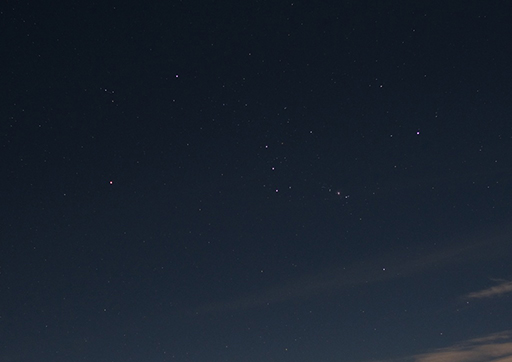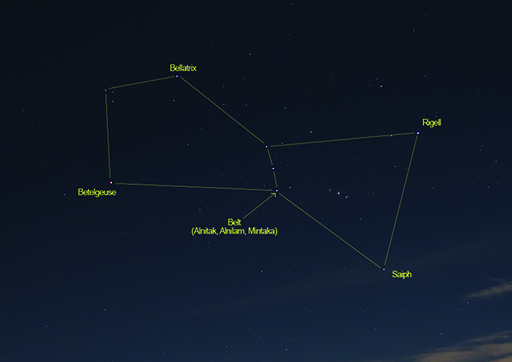1.1 The magnitude scale
If you have been able to make your own observations of constellations such as Orion you will have seen the main outlines of the constellation marked out by first and second magnitude stars, which are bright enough to be seen even from a site with some light pollution. In order to see the far fainter fifth and sixth magnitude stars in the constellation, you would need to be located at a good dark observing site with clear skies and to have your eyes fully dark adapted. Faint stars are more numerous than bright stars in the sky, and at a really dark site such as the observatory at Tenerife, so many stars are visible on a clear night that it can actually be difficult to make out the constellations!
To view larger versions of images on the course click ‘View larger image’ located underneath the figure on the left-hand side.

The original scale of magnitudes devised by Hipparchus was a simple classification into six groups of bright, fainter and faintest visible stars. Today, telescopes and scientific instruments can be used to measure the actual brightness of each star very precisely and so the magnitude scale has been given a mathematical basis and extended to cover objects far fainter than can be seen with the naked eye. On this numerical scale magnitude 1 stars are very bright and magnitude 6 stars very faint, as before. With accurate measurement stars can be given values in between, such as magnitude 2.7 for a star that is fainter than magnitude 2 but brighter than magnitude 3. (This may at first seem the wrong way round, with brighter stars having smaller magnitude numbers than fainter ones but as you get familiar with the scale you will soon get used to it.)
How bright a star appears as seen from the Earth depends on two things: the intrinsic brightness of the star (in other words, its total light output) and how far away the star is. A star of a particular intrinsic brightness further away from the Earth will appear fainter than a star of the same intrinsic brightness closer to the Earth because of the extra distance.
This course is concerned mainly with brightness as seen from the Earth which is referred to as the apparent magnitude, because it includes the effect of distance.
As one of the first people to use a telescope good enough for astronomical observations, Galileo extended the scale to include stars too faint to see with the unaided eye. Faint stars visible only in telescopes have magnitudes of +7, +8, and so on, with large telescopes such as COAST able to detect very faint stars of magnitudes up to +16. Larger observatory telescopes such as the Gran Telescopio Canarias and the Hubble telescope are able to go even fainter.
The scale has also been extended in the other direction – when placed on an accurate numerical scale some very bright stars turn out to be brighter than magnitude +1, and have been given values of zero or even negative magnitude values! On this scale Sirius, the brightest star in the sky, has a magnitude of –1.45.
Activity 1 Brightness of Sirius
What reasons can you think of to explain why Sirius appears so bright as seen from Earth?
Answer
Sirius is intrinsically quite a bright star, but importantly it is also relatively close to the Earth (only 8.6 light years away). Being so close means that it appears much brighter than many similar stars that are further away from the Earth.

